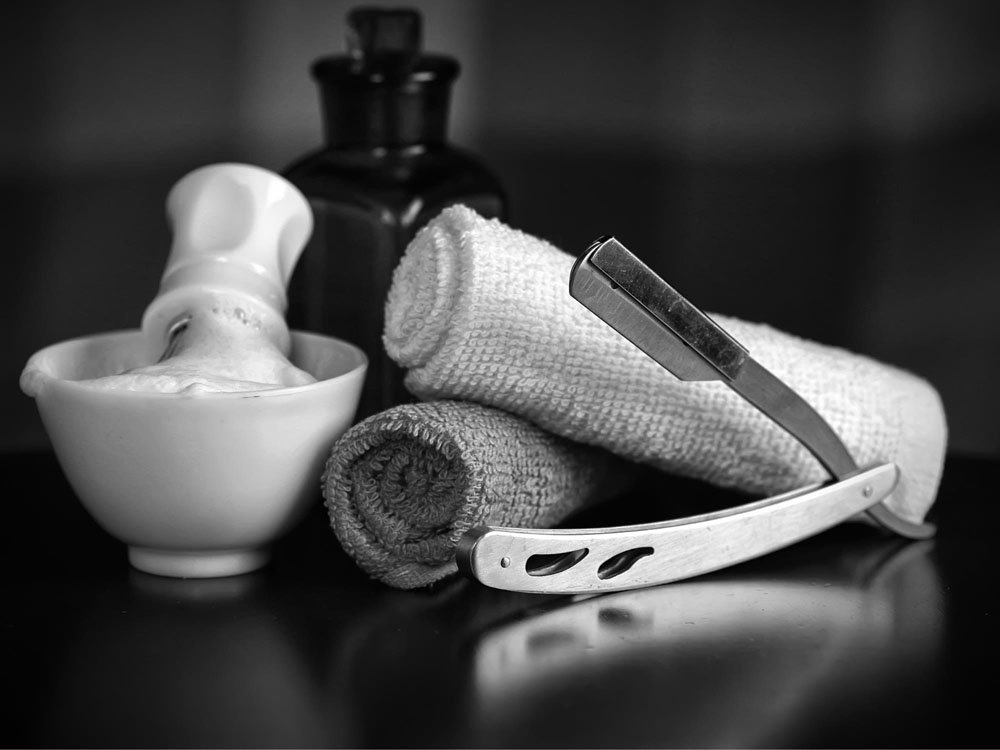The ancient art of straight razor shaving has experienced a renaissance in recent years, captivating enthusiasts seeking a closer, more refined shaving experience. Straight razors, with their singular blades and meticulous technique, offer a ritualistic approach to grooming that stands in stark contrast to the quick swipes of modern multi-blade razors. This guide endeavors to demystify the process, providing insight and instruction for those bold enough to wield the blade.
Chuck Harris, President at Saki Shears, a company renowned for its high-quality straight razors, speaks to the allure of this timeless tool: “There’s a certain romance to straight razor shaving. It’s a practice steeped in history and tradition, and when done right, it transcends the mundane act of hair removal, becoming a meditative ritual.”
Despite its storied past and devoted following, straight razor shaving can be an intimidating prospect for the uninitiated. The exposed blade demands respect and precision, but for those willing to master its use, the rewards are manifold. A straight shave razor not only provides an exceptionally close shave but also grants the user a sense of accomplishment and connection to a bygone era of gentlemanly elegance.
“Embracing straight razor shaving is like learning to play a musical instrument; it takes patience, practice, and a deep appreciation for the craft,” says Mr. John Barber, a master barber with over three decades of experience. “But once you’ve mastered the technique, there’s no going back. It’s a skill that will serve you for a lifetime.”
As we delve into the nuances of straight razor shaving, we’ll cover everything from selecting the right tools to perfecting your technique, ensuring that by the end of this guide, you’ll be well on your way to achieving the perfect shave.
Table of Contents
Understanding Your Tools
The journey to mastering straight razor shaving begins with understanding and selecting the right tools. The straight razor itself is the centerpiece of this grooming ritual, a tool that has stood the test of time, evolving in design yet remaining true to its original form. “A quality straight razor is an investment in your grooming routine, one that pays dividends in the quality of your shave and the health of your skin,” advises Chuck Harris.
When choosing a straight razor, pay attention to the material of the blade and the handle, as well as the size and shape of the blade. High-carbon steel blades are preferred for their sharpness and durability, while the handle should provide a comfortable and secure grip. The weight and balance of the razor are also crucial, as they influence the control and precision of your shave.
In addition to the razor, a leather strop is an essential tool for maintaining the blade’s sharpness. “Stropping is a skill in itself, and it’s vital for keeping your razor in top condition,” explains Mr. John Barber. He recommends stropping your razor before each shave to realign the blade’s edge and ensure a smooth, sharp cut.
A high-quality shaving brush and soap are also integral to the straight razor shaving experience. The brush helps to exfoliate the skin and lift the hairs, while the soap provides lubrication and protection. Dr. Sandra Smooth, a dermatologist specializing in men’s skin care, emphasizes the importance of using a brush and soap that are suitable for your skin type. “Choosing the right products can make a significant difference in the comfort and effectiveness of your shave,” she advises.
With your tools in hand, you’re ready to embark on the ritual of straight razor shaving, a process that begins with preparing your face and your razor for the task ahead.
Preparing Your Face and Tools

The secret to a successful straight razor shave lies in the preparation. A well-prepared face and razor are the foundations upon which a smooth, irritation-free shave is built. “Taking the time to properly prepare your skin and your tools is not just beneficial; it’s essential,” stresses Dr. Sandra Smooth.
Begin by washing your face with warm water and a gentle cleanser. The warmth of the water softens the hairs and opens the pores, creating the optimal conditions for a close shave. Dr. Smooth recommends spending a few minutes massaging the cleanser into the skin to fully hydrate the hairs and exfoliate the skin, removing any dead skin cells that could impede the razor’s path.
Next, prepare your lather. Using a quality shaving brush, swirl the bristles in your shaving soap or cream until a rich, creamy lather forms. “The brush is a crucial tool. It lifts the hairs and evenly distributes the lather, providing a protective cushion for the razor to glide across,” explains Mr. John Barber. Apply the lather to your face in circular motions, taking care to fully coat the hairs and skin.
While your face is being prepped, take a moment to strop your razor. Running the blade along a leather strop realigns the edge and ensures that it is sharp and ready for action. “A well-stropped razor is a joy to shave with. It cuts through the hairs effortlessly, reducing the risk of irritation and nicks,” says Chuck Harris.
With your face hydrated and your razor honed, you’re ready to shave. But this is not a race. Straight razor shaving is a deliberate, thoughtful process. Take your time, pay attention to your technique, and enjoy the experience.
The Shaving Technique
Mastering the art of straight razor shaving requires patience, practice, and a steady hand. The technique is as important as the tools you use, and it plays a crucial role in achieving a close, comfortable shave. “The straight razor is an extension of your hand, and learning to wield it with precision is key,” says Mr. John Barber.
Begin by finding a comfortable grip on the razor. Your index, middle, and ring fingers should rest on the back of the blade, while your pinky rests on the tang, and your thumb on the opposite side of the blade. This grip provides control and stability as you shave.
Next, focus on the angle of the blade. The optimal angle for straight razor shaving is around 30 degrees. “Maintaining the correct angle is essential. Too steep, and you risk nicks and irritation. Too shallow, and the blade won’t cut effectively,” warns Chuck Harris. Use short, controlled strokes, and let the weight of the razor do the work. There’s no need to apply pressure; the sharpness of the blade should be sufficient to cut through the hairs.
As you shave, pay attention to the direction of hair growth. Shaving with the grain reduces the risk of irritation and ingrown hairs. For a closer shave, you can perform a second pass against the grain, but this should be done with caution and only if your skin is well-prepared.
“Straight razor shaving is as much about the journey as it is the destination,” reflects Ms. Rachel Razor, a straight razor enthusiast and blogger. “Take your time, enjoy the process, and don’t get discouraged if it takes a few tries to get it right.”
After the shave, rinse your face with cold water to close the pores and apply a soothing, alcohol-free aftershave balm. This will help to calm any irritation and moisturize the skin.
Troubleshooting and Advanced Tips
Even with the right tools and technique, straight razor shaving can be a challenging skill to master. Here, we address some common issues and provide advanced tips to elevate your shaving experience.
Common Issues and Solutions
- Irritation and Redness: If you experience irritation, ensure you are not applying too much pressure during the shave. Let the razor do the work. Additionally, check that your blade is sharp and your lather is adequately protective.
- Nicks and Cuts: A steady hand is crucial to avoid nicks. Make sure your skin is well-prepared and taut, and always shave with the grain during your first pass.
- Uneven Shave: An uneven shave often results from inconsistent blade angle or pressure. Practice maintaining a consistent 30-degree angle and use short, controlled strokes.
Advanced Shaving Techniques
Once you are comfortable with the basics, you can explore advanced techniques to further enhance your shave.
- Skin Stretching: Use your free hand to stretch the skin, creating a smoother surface for the razor to glide across.
- Multiple Passes: For an ultra-close shave, perform a second or third pass, re-lathering between each and shaving across or against the grain.
- Experiment with Different Blades: Different blades offer varying levels of sharpness and flexibility. Experiment to find the one that best suits your skin and hair type.
Straight razor shaving is a time-honored tradition, a skill that rewards patience and precision. “Embracing this ancient art form is a commitment, but it’s one that pays off in the quality of your shave and the health of your skin,” concludes Chuck Harris.
As you continue on your straight razor journey, remember that practice is key. Each shave is an opportunity to refine your technique and deepen your appreciation for this meditative grooming ritual. So take your time, enjoy the process, and welcome to the world of straight razor shaving.





